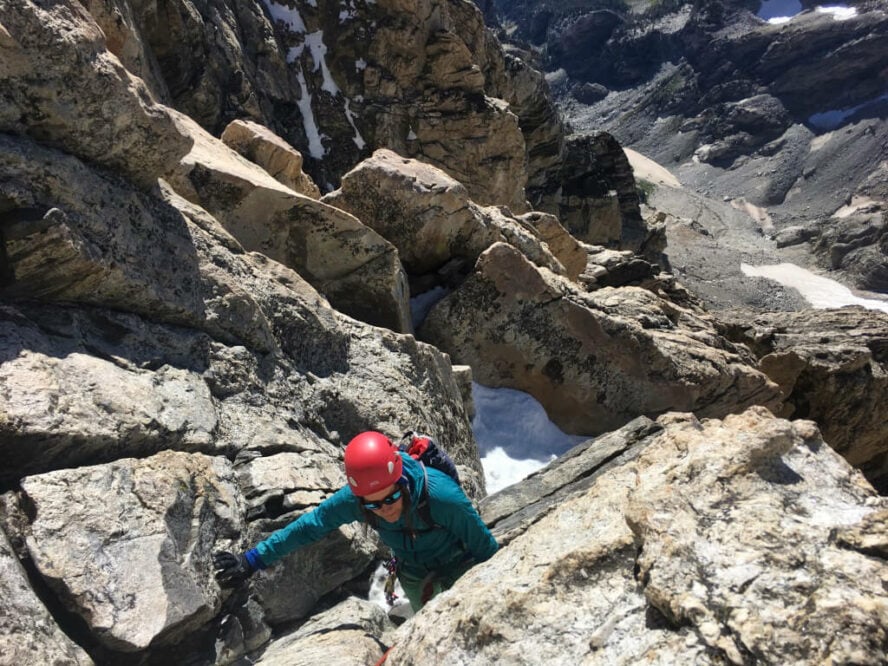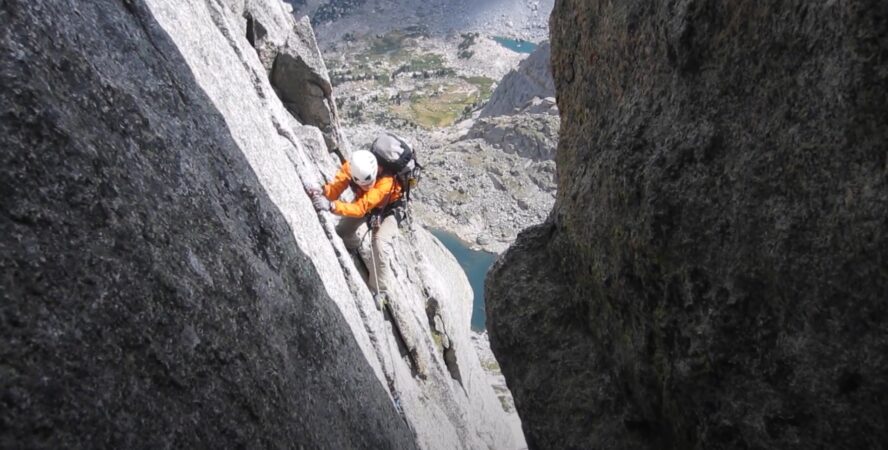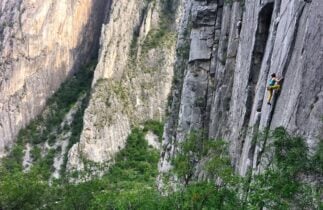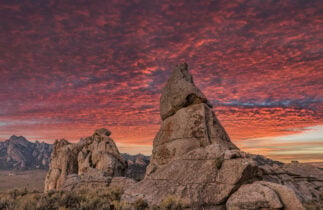The Best Places for Rock and Alpine Climbing in Wyoming
Table of Contents
An uncommon contender for one of the best places to rock climb in the world, Wyoming presents a landscape so expansive and wild that even in modern times, visiting this state feels like taking a step back into a previous century. As someone who likes their climbing remote and quiet, Wyoming checks a lot of boxes for me. I venture from the high mountains of the Tetons and Wind River Range, down to the sport climbing of Wild Iris. Wyoming contains some of the best climbing you may ever do in your life as a rock climber or alpinist, but typically you’re going to have to earn it.

Approaches may be tame in areas such as Sinks Canyon or Ten Sleep, but the Tetons will require an hour of approach per pitch of climbing. Even though approaches might take a while, I have found the journey to only add to the classic feeling of this amazing state. Plus, the long drive it takes to get to your climbing destination gives you plenty of time to get excited about the quality you will be greeted with upon arrival!
Wyoming is the land of the Shoshone, Blackfeet, Arapahoe, Cheyenne, Crow and so many others. Their presence, though diminished, should still be appreciated, learned about and respected by climbers who visit this spectacular area of the country. That history fuels my joy in this landscape.
1. Bear’s Lodge (Devils Tower)
Devils Tower National Monument, or Bear’s Lodge as it’s known by Indigenous people, is an iconic landmark, and one of the best places for climbing in the USA. Standing out in the surrounding prairie, Bear’s Lodge forms a prominent shadow across the vast open grassland. The first recorded ascent by two local ranchers in 1893 involved pounding large, wooden pegs into the cracks, some of which are still visible today. The history of climbing the formation is storied with interesting ascents and even a parachute landing on top, resulting in the individual being stranded on the summit in the cold for six days.
These days, Durrance, Walt Bailey, Soler, and Hollywood and Vine are some of the more popular routes. Routes from 5.6-5.8 are generally wide or offwidth in nature, while 5.9-5.10 are more hand sizes and 5.10+ start thin ranging to finger sizes. Though I have not been to Devils Tower, my clients and friends who have, talk about the feature like it’s a piece of climbing history that cannot be missed. Standing on the summit once is a must. Climbing a crack in all of the sizes gives you a great flavor of the tower.

Things to know before climbing Devils Tower
To top it off, a stay at the Devils Tower Lodge is the way to go! Frank Sanders, owner of the Lodge holds the spirit and history of the tower in his great storytelling. It should be noted, the month of June is a sacred month at the Tower for Native Americans. A voluntary climbing moratorium is in place and while it is by choice, I highly encourage everyone to recognize this tradition as climbing the Devils Tower area is a privilege. We should recognize that we are not the only group who sees the power of the Tower! There is also an annual closure for nesting falcons. To learn more about Devils Tower closures, visit the National Parks Service website.
The history of the formation is storied with interesting ascents and even a parachute landing on top, resulting in the individual being stranded on the summit in the cold for six days.



Bear’s Lodge (Devils Tower) - Good to Know
Traditional
Phonolite Porphyry
Spring/ late summer
South and East Faces
Devil’s Tower approach trails and Durrance Route climbing map
Hanging out with Frank Sanders
Devil’s Tower Lodge
2. Vedauwoo
The name Vedauwoo (Vee-Dah-Voo) is debated. As far as anyone can tell, it is a highly anglicized version of an Arapaho word meaning “from the earth.” If you’re anything like me and a climber, when you hear the name Vedauwoo you think offwidth, rough and burly. You’re right! That is, if that is what you have come for. If so, you will not be disappointed as routes from 5.6-5.14d will be found here in the wide. If you want to hone those skills, this is likely the best granite climbing for that. Don’t let the abundance of wide cracks fool you! Vedauwoo holds a lot of climbing of all styles, including some bolted (not sport) face routes.

Start at Middle Parallel Space to climb offwidths and granite
On day one, I thought I was here to climb offwidths. I went straight to a route called Middle Parallel Space on the Nautilus since it holds a grade of 5.9. It’s quite secure and well protected as the opening moves require a single BD#5 nut and secure chicken-winging to a chimney with a hand crack on one side. The first pitch has rappel anchors and has the option of great granite friction as a second pitch to the top. Like I said, wide isn’t the only thing here, however!
Step up your game at Captain Nemo and the nearby Blair areas
Friday the 13th’s first pitch contains amazing 5.10 fingers and hands up a 50-foot corner to a bolted anchor. Feeling strong? Continue through the 5.11 lieback roof of the second pitch! A great moderate first pitch of a harder climb is Captain Nemo. The first pitch is an awesome 80 feet of hand and fist crack to a bolted anchor. Again, this has a harder 5.10+ second pitch that pulls out of a traversing roof to sloping jugs on steep terrain.
A few of my favorite climbs in Vedauwoo
For more quiet climbing with a bit longer approach, I recommend one of the Blair areas. Nautilus is a one-minute walk and only five minutes depending on your destination climb. For a great hand-crack primer, Le Petit Arbre’s first pitch goes at 5.6 and is quite secure, as well as consistently well protected. Just left is the long, Intimidation at 5.9+ — a journey of extremely varied climbing up the center of the face. For a good sport climb, Missiles for Jesus is a stellar 5.10 climb at the Pretzel Wall.
There are many more sport routes dotted across the areas. Of course, if you came here for the offwidths, you will not be in short supply. The Mountain Project features a map for climbing the Vedauwoo in Wyoming for more detailed information on routes.
What to know when planning your climb at Vedauwoo
For camping, you can camp along FR 700, which passes right by the climbing areas. You can’t camp in the parking lots, however. There are a variety of marked campsites along the road. The road can get quite rough in spots the further you go, but generally, any car should be able to go quite far. Laramie is your nearest town and is an awesome university town. All of the supplies you can need. For your gear needs, Atmosphere Mountainworks is a good spot.
As it says in the popular guidebook Rock Climbing at Vedauwoo Wyoming, “The wind season runs from early January to late December” so prepare to move locations based on current wind conditions. Summer can be hot but shade is quite easy to find. Many Laramie and nearby Front Range locals practice winter “Woo” climbing, but even in the sun if paired with wind, it can be trying. Climbing at Vedauwoo is especially amazing in the Fall, when the weather stabilizes and the aspens begin to change!
Don’t let the abundance of wide cracks fool you! Vedauwoo holds a lot of climbing of all styles, including some bolted (not sport) face routes.

Vedauwoo - Good to Know
Traditional
Sherman Granite
Spring through fall
Nautilus
Climbs of the Eastern Medicine Bow National Forest by Rob Kelman
Mountain biking (Turtle Rock Loop and many others)
Forest Service Dispersed Camping (Mark sites only)
3. Ten Sleep
Until three or four years ago, you may have never heard about Ten Sleep. This area has undergone a huge growth spurt, and it shows in the growing number of guidebooks that continue to spawn. It’s popularity is understandable because of the limestone, care taken to upkeep hardware, the liberal bolting, loaded cliffs of climbing at all grades and the sense of the area being a climber’s destination. The Dolomite Limestone offers stellar pockets, sharp crimps and the general feeling that you are climbing in a gym.

If you climb 5.10 fairly consistently in the gym, you will have no problems finding routes here. Most areas have an abundance of routes from 5.10 and beyond. Areas such as Shinto and Big Kahuna Pillar contain a great number of routes at the 5.10 grade. For 5.11, head over to almost any area. Just to name a few, Back Forty, Shinto, and Circus Wall. If you’re interested in 5.12 and on, you can look at areas like Shinto and Ark offer abundant 5.12 routes and Grasshopper harbors a few 5.13’s.
The Dolomite Limestone offers stellar pockets, sharp crimps and the general feeling that you are climbing in a gym.

Ten Sleep - Good to Know
Sport
Dolomite Limestone
Summer
Ten Sleep Brewing (great camping options, too!)
Dispersed Camping (Old HWY 16), Meadowlark Lake Lodge
Jackson Hole Mountain Guides
4. Lander (Sinks Canyon & Wild Iris)
Sinks Canyon is a year-round playground, with climbing possible during the winter on south-facing routes. Wild Iris is the quintessential summer destination. While there is indeed great, traditional climbing here that I personally enjoy on the sandstone and granite crags in Sinks, but the real draw of the climbing here is at the limestone sport crags of Wild Iris and Sinks. Similar to Ten Sleep, the rock here is Dolomite Limestone and “sports” pockets, crimps and steep, overhanging jug hauls.

Best areas to access in Lander
Lander is a must-have stop on any climbing trip that passes through Wyoming. In Sinks, my favorite area is the Killer Cave. With its steep and juggy nature, Killer Cave meets all of my requirements for a great day of sport cragging. If you head up in elevation to Wild Iris to avoid the hot peak of the summer months, Blooming Rose has a great variety of climbing to 5.10+ for everyone. If you’re looking to pull a bit harder, then I recommend Rodeo Drive as a great destination!
For more detailed information on routes, the Mountain Project features a map for climbing in Lander.
What to expect in climber-friendly Lander
The access to the Sinks Canyon area is super simple. This area is extremely attractive for the traveling climber in Wyoming thanks to the routes being under ten minutes from town and with five to fifteen-minute approaches. There is no shortage of outdoor stores in Lander, and my personal favorite is Wild Iris Mountain Sports. Sinks Canyon is predominantly a climber-centric town. Support the climber owned Lander Bar on your rest day!
Camping spots are abundant. There’s the Sawmill Campground and the Popo Agie Campground in the Sinks Canyon State Park, and then plenty of dispersed camping below OK Corral and along the FS Access Rd.
With its steep and juggy nature, Killer Cave meets all of my requirements for a great day of sport cragging.

Lander (Sinks Canyon & Wild Iris) - Good to Know
Sport, trad, bouldering
Limestone, Sandstone, Granite
Year-round, but summer can get hot
Cabin Boulders, Fairfield Hill (Sport), The Sanctuary (Granite Trad), Sandstone
Lander Rock Climbs 2018 by by Steve Bechtel, Kyle Duba, and Ben Sears
Popo Agie Waterslide
Forest Service camping
5. Wind River Range
Nothing says “wilderness” like a trip to the Wind River Range. Even the drive from nearby Boulder involves 30-plus miles on dirt roads to get to the remote trailhead. The nearest popular climbing is a 4-mile approach or 8 miles to the Cirque of the Towers. Even though the popularity of this area continues to grow for climbers, the feeling of wilderness is still remarkable here. The nature of the climbing here is alpine and adventurous and not for newer climbers. If going to the Cirque of the Towers, you need to have backpacking, camping and navigation skills.
You’ll also need alpine climbing knowledge to ensure you can escape the impending afternoon thunderstorm with speed, efficiency and confidence in your route finding and system implementation.

Cirque of the Towers is the main draw for alpine climbing routes
The Cirque of the Towers is the main attraction here even though Haystack Mountain near Deep Lake is only 4 miles from the trailhead, boasting amazing climbing such as Minor Dihedral (5.9) and Southern Wall Left (5.10c) at Big Sandy. With an 8-mile approach and sometimes faint trail over mountain terrain, the Cirque is remote and real. Come prepared for alpine-rock conditions, especially arriving early season (before mid-July) when snow can still be expected in decent gullies on north-facing aspects. Rockfall is a real hazard here and all of the tactics of alpine climbing should be taken into consideration. That said, the rock here is generally quite amazing!
Routes like the Northeast Buttress on Pingora, East Ridge of Wolf’s Head, North Face of Mitchell Peak, and Black Elk on Warbonnet are some of the biggest draws here. The Mountain Project documented climbing routes in Wind River Range for more detailed information.
Tips for navigating wildlife and rest days when climbing at Wind River Range
Marmots and sometimes bears are an issue here and care should be taken in dealing with your food. I highly recommend bringing an Ursack on your trip to store your food. Be sure to treat your water as with increased impact, the water cannot be guaranteed to be clean enough to consume unfiltered.
You shouldn’t miss the International Climbers Festival. Occurring every July, this festival is a stewardship, mentorship and social gathering of climbers of all stripes from all over the world. One of the longest lasting climbing festivals in the country, the ICF is a gathering to not be missed by any climber!
Even though the popularity of this area continues to grow for climbers, the feeling of wilderness is still remarkable here. The nature of the climbing here is alpine and adventurous and not for newer climbers.

Wind River Range - Good to Know
Alpine and traditional
Granite
Summer
Haystack/ Cirque of the Towers
Cirque of the Towers and Deep Lake by Steve Bechtel
Hiking and swimming in the abundant lakes
Big Sandy Lake, Lonesome Lake
6. Grand Teton National Park
Grand Teton National Park is the birthplace of American alpinism, and fun fact, American rock guiding. The Grand Teton’s profile when viewed from the east is actually the logo of the American Mountain Guide’s Association. The Tetons are likely some of the most photographed mountains in the entire country. There is a good reason for that. Due to a fault line running laterally along the range, there are no foothills between the valley and the mountain crest. The Tetons rise a stunning 7,000 feet in prominence from the valley floor. As a result, the Tetons are so appealing to climb.

Guide’s Wall is worth the effort for protected, alpine climbing
Although, climbing here will not happen without some effort. “A pitch of rock climbing will require a mile of approach” is a common joke around Jackson Hole. It generally holds true. To approach Cascade Canyon’s popular Guide’s Wall without taking the ferry across Jenny Lake, you must hike 5 miles to the base. You will often be rewarded for your efforts, however. On routes like Irene’s Arete, the grueling approach will afford you stunning vistas, well-protected 5.9 climbing and great rock despite its alpine location.
The most prominent alpine rock climbing on North Ridge
The Grand Teton is, of course, the main attraction with the North Ridge being a prominent, sustained formation at 5.8. It requires a serious approach with alpine rock and snow-travel skills. One of my personal favorites is the Snaz in Death Canyon. Don’t let the name fool you, it’ll only take 4 miles of approach to some of the best 5.9-10 climbing in the Teton. Back in Cascade Canyon, No Perches Necessary will offer quality 5.9 climbing in a wide crack. Best of all, it has a very short approach!
Plan ahead for visiting the Grand Teton National Park
Summer time is definitely a good time to arrive in the Tetons. Be prepared to pay a visit to the visitor center to ensure you’re climbing with a permit, if planning to spend an overnight to climb routes like Irene’s Arete or one of the peaks. Unlike much of Wyoming, this is a national park and given its proximity to Yellowstone, is a major draw for tourism. While it is possible to escape the crowds on many rock climbs, be ever vigilant when driving through the park. Obey the speed limits, especially in regards to wildlife.

If you are looking for gear, my personal pick is Teton Mountaineering. If you’re looking for lodging, there is free but crowded camping at Shadow Mountain. If you want to be steeped in classic Teton climbing history and be inspired. I highly recommend the American Alpine Club Climber’s Ranch.
The Grand Teton is, of course, the main attraction with the North Ridge being a prominent, sustained formation at 5.8. It requires a serious approach with alpine rock and snow-travel skills.




Grand Teton National Park - Good to Know
Alpine, traditional
Gneiss, granite
Summer
Cascade Canyon
Paddling the Gros Ventre and Snake River, fly fishing, mountain biking, backcountry skiing
Shadow Mountain Free Dispersed FS Camping, Curtis Canyon Campground, AAC Climbers Ranch






